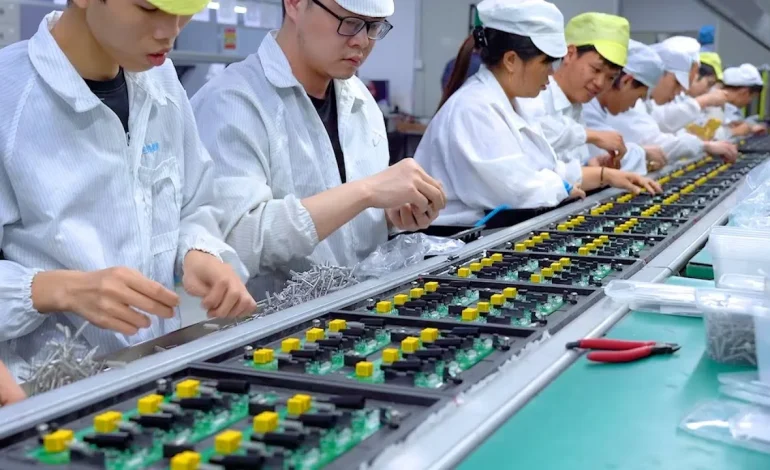China’s AI Chip Export Surges in Q3 2025

Introduction
China’s semiconductor industry achieved a significant milestone in the third quarter of 2025, as exports of AI chips surged amid increasing global demand for high-performance computing solutions. According to the Ministry of Industry and Information Technology (MIIT), Chinese manufacturers exported $7.3 billion worth of AI-specific integrated circuits (ICs) in Q3, marking a 28% increase compared to the previous quarter. The growth highlights China’s expanding footprint in the global AI hardware market, driven by both domestic adoption and strategic international partnerships.
Rising Global Demand
Analysts attribute the surge to strong demand in Southeast Asia, Europe, and parts of North America. AI chips are critical for cloud computing, autonomous systems, and data center operations, sectors experiencing accelerated growth as enterprises expand AI-driven services. Wu Cheng, Senior Analyst at CCID Consulting, stated, “China’s AI chip exports are no longer limited to traditional consumer electronics. We are seeing industrial-grade deployments in smart factories, healthcare, and autonomous vehicles.”
Data from the China Semiconductor Industry Association (CSIA) shows that shipments of neural processing units (NPUs) and application-specific integrated circuits (ASICs) accounted for 65% of total AI chip exports, signaling a strategic shift toward higher-value components. Companies such as HiSilicon, Cambricon Technologies, and Horizon Robotics are leading the charge, with reported production capacities exceeding 2 million units per quarter.
Government Support and Policy Drivers
The surge also reflects continued government investment in AI hardware and supportive export policies. The MIIT recently announced a $450 million fund dedicated to semiconductor R&D, focusing on high-performance chips for AI, autonomous driving, and quantum computing applications. Policies prioritizing domestic design and manufacturing capabilities have reduced reliance on foreign suppliers, enabling Chinese firms to compete internationally.
According to Zhang Lei, Director at MIIT’s Semiconductor Division, “Strategic support, including tax incentives and research grants, has allowed domestic AI chip producers to scale production rapidly while meeting global quality standards.” Additionally, new export facilitation programs have simplified customs procedures, reducing lead times for international shipments by an average of 12 days compared to last year.
Industry Collaboration and Innovation
Partnerships between Chinese technology companies and foreign firms have been crucial. Huawei, for instance, recently collaborated with European cloud providers to integrate AI acceleration chips into data centers, enhancing energy efficiency and computational throughput. Meanwhile, smaller startups like Bitmain and Sipearl are introducing innovative packaging techniques and low-power chip architectures, attracting attention from global AI service providers.
Experts note that China’s AI chip ecosystem benefits from vertical integration. Companies increasingly combine design, manufacturing, and cloud service deployment, creating end-to-end solutions that enhance both domestic adoption and export competitiveness.
Challenges and Global Competition
Despite the growth, Chinese AI chip exports face challenges, particularly amid ongoing geopolitical tensions and trade restrictions. Export controls on advanced semiconductor manufacturing equipment and certain high-end lithography tools could constrain future capacity expansion.
Dr. Li Xinyu, a semiconductor researcher at Tsinghua University, remarked, “While China’s mid-range AI chips are competitive, accessing the most advanced fabrication technology remains a bottleneck. Companies need to innovate in chip architecture and energy efficiency to maintain export momentum.”
Additionally, competitors in South Korea, Taiwan, and the United States continue to develop AI chips targeting similar markets. Analysts suggest that continued investment in design talent, IP protection, and R&D will be essential for sustaining China’s growth trajectory in the AI chip sector.
Market Outlook
Looking ahead, the Chinese AI chip market is expected to maintain double-digit growth in both domestic consumption and exports. Forecasts from IC Insights project a 23% year-on-year increase in AI chip shipments for Q4 2025, driven by cloud services, autonomous vehicle applications, and smart city infrastructure projects.
Industry insiders highlight that AI adoption in sectors like healthcare diagnostics, financial modeling, and manufacturing automation will increasingly rely on high-performance, energy-efficient chips. This trend positions Chinese exporters to capture more market share, provided they continue innovating and navigating global trade dynamics.
Conclusion
China’s AI chip export surge in Q3 2025 underscores the country’s growing influence in the global AI technology landscape. Government support, strategic collaborations, and industry innovation have combined to create a robust ecosystem capable of producing high-value AI hardware. While challenges such as trade restrictions and competitive pressure persist, Chinese AI chipmakers are poised to continue expanding their global footprint, signaling a new phase of technological leadership in semiconductor innovation.






